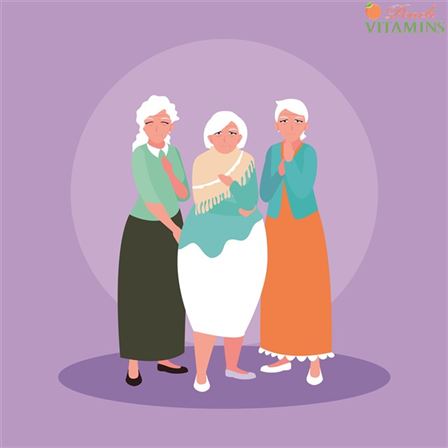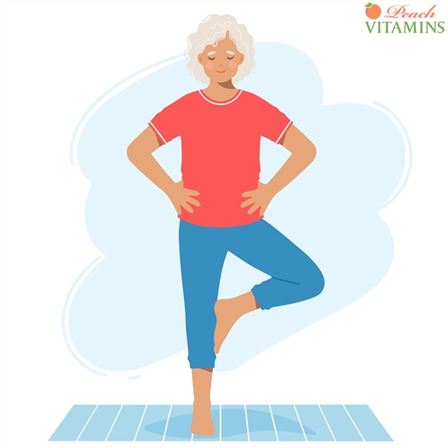Inflammation is one of the biggest enemies of longevity, so by reducing it, you will help ensure a long life. One way of doing so is through intermittent fasting. Intermittent fasting for women over 60 can be very effective in reducing inflammation. Intermittent fasting has been gaining popularity in the treatment of diabetes, cardiovascular disease, and others. Many people have realized just how effective intermittent fasting is.
Intermittent fasting methods are not new, but they are becoming more popular, and there are many different types that we should know about. There are three main categories: time-restricted feeding, periodic eating patterns or cycles, and continuous calorie restriction. The first two are also known as alternate day fasting, while continuous calorie restriction refers to diets where calories are restricted throughout the entire week. Let’s take a look at each method individually.
Time-Restricted Feeding
The most common form of intermittent fasting involves restricting food intake during certain hours of the day. This type of diet also works for people with diabetes who need to control their blood sugar levels. In this case, the recommended period would last in the fasting window from 12 noon until 8 pm.
During these periods, no food except water is allowed during this fasting period. However, after eight hours, when your body starts fat burning, you may eat whatever you want. Some studies show that it helps reduce insulin resistance which leads to better health outcomes.
Nighttime fasting is another variation of time-restricting fasting. During nighttime fasts, some researchers recommend consuming only liquids such as tea, coffee, broth, etc. Others suggest avoiding solid foods altogether. While both approaches work well, the latter seems to produce greater benefits than the former.
Periodic Eating Patterns
The second category includes various dietary plans such as 5/2, 4/1, 3/3, etc. These are all variations on the same theme; every other day, you consume only 500 calories, whereas the rest follow normal caloric consumption. You could say that these are “fasted” days because you do not consume any calories whatsoever.
You drink plenty of fluids on the fasted days like coffee, tea, juice, soda, milk, broth, soup, etc. If you prefer, you can add some healthy fats like avocado, olive oil, coconut oil, nuts, seeds, fish oils, flaxseed oil, chia seed oil, etc.
Continuous Calorie Restriction
A continuous calorie restriction is another variation on the theme of intermittent fasting. Unlike the previous examples, here, you don’t skip meals altogether. Instead, you restrict yourself to 2000 calories per day. This means that if you normally eat 2500 calories per day, you need to cut it down to 2000.
As mentioned before, once you start consuming less than 2200 calories, your metabolism slows down and begins using stored energy rather than carbs. So basically, what happens is that your body burns off excess fat stores. Studies suggest that this intermittent fasting program reduces cholesterol, triglycerides, LDL and increases HDL.
Intermittent Fasting For Women Over 60 – How Long Can You Do Intermittent Fasting?
Your weight loss journey to reduce body weight depends on age, gender, lifestyle habits, genetics, physical activity level, stress management techniques, sleep quality, emotional state, nutrition plan, exercise routine, supplements, medications, hormone balance, etc.
If you want to lose weight within 30 days, I highly recommend starting with an intermittent diet protocol. It works best if you stick to it consistently without skipping a single meal. Most experts agree that the ideal duration of intermittent fasting is between 24 – 36 hours. The longer you go without eating, the more likely you are going to experience negative side effects.
Healthy foods should make up at least 50% of your daily intake, while unhealthy ones like junk food should account for less than 20%. Your goal should always be to keep your macronutrient ratio balanced throughout the week. In general, protein makes us feel fuller faster than carbohydrates or fat.
Are You Eating Enough Fruits & Vegetables?
You must include fruits and vegetables in your diet. They contain fiber, vitamins, minerals, antioxidants, phytonutrients, enzymes, amino acids, and many other nutrients essential for good health.
Blood sugar Control: Fiber helps reduce blood glucose levels after each meal. Also, they lower insulin resistance. Collagen-boosting foods can also improve skin elasticity and firmness.
Antioxidants: Antioxidant-rich foods protect our cells from free radical damage caused by toxins and radiation. Free radicals cause cell aging and may lead to additional harmful effects on the body.
Protein Foods: Protein provides important building blocks for muscles and bones. Proteins also provide satiety signals to the brain when consumed together with carbohydrate sources. Some proteins are complete, while others are incomplete.
Ultimately, your food choices determine whether you experience weight gain or weight reduction. If you want to maintain a healthy weight, try incorporating these tips into your everyday dietary regimen. Remember, moderation is key!
Is Intermittent Fasting Safe For Senior Women?
Metabolic health is important for everyone, especially seniors who suffer from chronic diseases at higher rates. Metabolism plays a huge role in maintaining good health. When we talk about the metabolic rate or basal metabolic rate, we refer to the amount of energy required to maintain basic bodily functions such as breathing, heart beating, digestion, brain function, immune system, blood flow, etc.
When our BMR decreases due to aging, it becomes harder for us to stay fit and active. In fact, many older adults find themselves struggling to get up every day. They also struggle to keep their muscles strong enough to move around easily. As they grow old, they often become weak.
Your mental health also suffers when your BMR drops. Your ability to concentrate declines along with your memory. With reduced cognitive abilities comes difficulty remembering things and making decisions. All of which makes it hard for you to live independently.
One thing that helps senior citizens overcome these challenges is regular exercise. Exercise health benefits improve circulation throughout the entire body. It boosts immunity and strengthens bones. Regular aerobic exercises improve lung capacity, increase muscle mass, burn unwanted belly fat, reduce the risk of depression, anxiety, and dementia.
If you decide to try intermittent fasting for women over 60, consult your doctor first. Your nutrition experts should also monitor your progress closely while following the recommended guidelines for a prescribed diet plan.
Is Intermittent Fasting An Eating Disorder?
Intermittent fasting is not an eating disorder but rather a healthy way to lose weight and maintain health. The idea behind intermittent fasting is to eat fewer calories for a shorter period of time. This allows you to consume fewer calories while still getting all the nutrients you need from food.
Diet trends come and go. While some diets work better than others, there’s no denying that most diet plans require extreme lifestyle changes. That’s why intermittent fasting isn’t really considered a diet plan per se. Rather, it’s more like a new approach to nutrition.
Energy levels may drop during periods where you don’t eat anything. However, this doesn’t mean that you’re starving yourself. You simply aren’t consuming any calories. Therefore, if you feel hungry after skipping meals, then you might actually be experiencing hunger pains.
Does Fasting Reverse Aging?
Regular, short-term fasts may slow down the cellular damage caused by free radicals. Free radical damage occurs naturally during normal cell respiration. However, certain environmental toxins like cigarette smoke, pollution, radiation, poor diets, alcohol consumption, lack of sleep, obesity, high sugar intake, and other unhealthy lifestyles all contribute to increased levels of oxidative stress.
Oxidative stress causes cells to produce even more free radicals. These free radicals then attack DNA molecules causing them to break apart into smaller pieces called nucleotides. Nucleotide fragments accumulate inside mitochondria, where they interfere with mitochondrial protein synthesis.
Brain health depends on the proper functioning of proteins made by genes. If there’s too much-damaged DNA floating around inside the nucleus, gene expression cannot occur properly. This leads to decreased production of neurotransmitters and impaired learning and memory.
In addition, some studies suggest that fasting increases autophagy, the process responsible for recycling worn-out organelles and clearing away toxic waste products. Autophagy is essential for healthy health issues because it keeps organs clean and prevents the accumulation of harmful substances.
Conclusion
Intermittent fasting for women over 60 is a great alternative to fad diets that are hard to maintain. Time-restricted eating helps reduce body fat without restricting calorie intake or depriving oneself of vital nutrients. It’s easy to incorporate intermittent fasting into daily routines as part of a balanced diet.
FAQs for Intermittent Fasting For Women Over 60
How Can A 60 Year Old Lose Belly Fat?
Intuitive eating is based on the premise that we should listen to our bodies when deciding what foods to eat. In fact, your body knows exactly which foods to burn off first! When you skip breakfast, your body starts burning stored fats instead of carbs. Your metabolism slows down, making it harder to shed those stubborn belly bulges.
The best thing about intuitive eating is that it works regardless of age. Even though many older adults struggle with losing weight due to declining hormone function, their metabolisms remain strong.
Intuitive eating techniques can easily apply to anyone who wants to get rid of excess pounds.
How Can I Speed Up My Metabolism At 60?
The time-restricted eating method involves limiting food intake to specific times throughout the day. The most common approach is to only consume between 12 pm – 8 pm. While this sounds restrictive, research shows that it does not negatively impact energy levels. Instead, it improves insulin sensitivity and reduces appetite.
If you want to speed up your metabolism at 60, try cutting out carbohydrates. Carbohydrates cause blood glucose levels to spike, which triggers an increase in insulin secretion. Insulin stimulates lipogenesis while inhibiting lipolysis. By avoiding carbohydrates before noon, you prevent these spikes in blood glucose and insulin.
What Is the “Senior Citizen” Age? 65 – or Maybe Not
Source: (after55.com)
The 48+ Best Senior Citizen Jokes – UPJOKE
Source: (upjoke.com)
[wps_products product_id=”1638122029091″ html_template=”product.php”]





